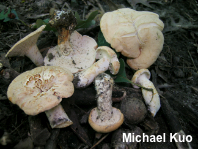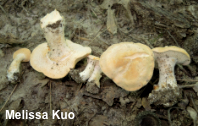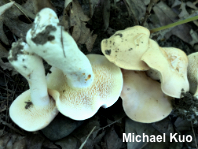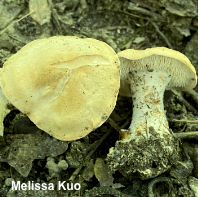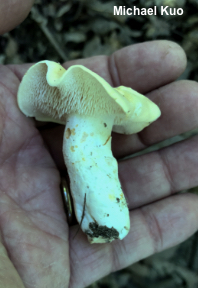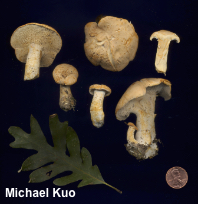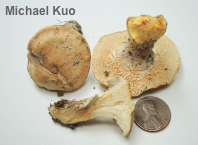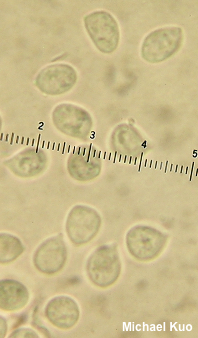| Major Groups > Toothed Mushrooms > Hydnum > Hydnum subtilior |

|
Hydnum subtilior [ Basidiomycota > Cantharellales > Hydnaceae > Hydnum ... ] by Michael Kuo Apparently common in eastern North America from roughly Interstate 70 southward, Hydnum subtilior is a smallish to medium-sized species with pale orange colors and a stem that is usually a bit longer than the width of the cap. It is associated with hardwoods in a variety of forest types. Under the microscope, Hydnum subtilior features broadly ellipsoid spores about 8 µm long. Hydnum subtilior is one of several recently-named North American species, most of which have been hanging out, away from the DNA-study rain, under the "Hydnum repandum" umbrella in North American treatments. However, the true Hydnum repandum is limited to Europe, it turns out. Similar pale orange North American species include Hydnum subolympicum, generally larger, associated with hardwoods east of the Rockies—and Hydnum washingtonianum, associated with conifers, known from Newfoundland and Labrador, Washington, and California. Description: Ecology: Mycorrhizal with hardwoods; growing scattered or gregariously on the ground; summer and fall; distributed east of the Mississippi River from Illinois to the Carolinas, southward to Florida and Mexico. The illustrated and described collections are from Illinois. Cap: 2–6 cm wide; broadly convex, becoming planoconvex; dry; soft and kid-leathery to the touch; becoming finely pocked; pale dull orange to nearly whitish. Undersurface: Not running down the stem, or just beginning to do so; covered with densely packed, soft spines that are round in cross-section and measure 2–4 mm long; whitish creamy; not bruising. Stem: 3–6 cm long; 1–2 cm thick; dry; bald; whitish; discoloring and staining pale yellow-orangish, then brownish orange. Flesh: Whitish; slowly orangish to brownish orange when sliced; somewhat brittle. Odor and Taste: Sweetish, not distinctive. Chemical Reactions: KOH yellowish on cap surface. Iron salts negative on flesh, spines, and cap surface. Microscopic Features: Spores 6–9 x 5–6.5 µm; broadly ellipsoid, with an apiculus; smooth; hyaline in KOH. Basidia 2- and 4-sterigmate; 26–30 x 6–7 µm; subclavate. Pseudocystidia 28–40 x 2–5 µm; mostly cylindric with rounded apices, but occasionally fusiform or sublageniform; thin-walled; smooth; hyaline in KOH. Pileipellis not clearly differentiated; cap surface hyphae tangled, 2–4 µm wide, ochraceous to golden in KOH, with clamp connections. REFERENCES: Swenie & Matheny, 2018. (Swenie et al., 2018.) Herb. Kuo 08080904 (paratype), 08162001. This site contains no information about the edibility or toxicity of mushrooms. |
© MushroomExpert.Com |
|
Cite this page as: Kuo, M. (2020, September). Hydnum subtilior. Retrieved from the MushroomExpert.Com Web site: http://www.mushroomexpert.com/hydnum_subtilior.html |
